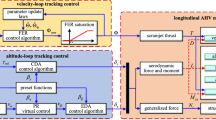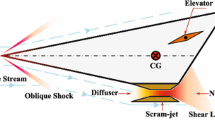Abstract
This paper investigates the state-constrained controller design of a hypersonic flight vehicle (HFV) based on an asymmetric barrier Lyapunov function (ABLF). The robust adaptive back-stepping controller with integral terms is applied for the HFV longitudinal dynamics. Considering the asymmetric angle of attack (AOA) constraint caused by the unique structure and scramjet, the controller is modified by constructing an ABLF, where the asymmetric constraint on AOA tracking error is introduced. Combined with the constraint on virtual control, the AOA is restricted to a predefined asymmetric interval. The system stability and the AOA constraint are guaranteed via Lyapunov analysis. Simulation results verify that the AOA can be kept in the given asymmetric interval while the altitude reference signal is tracked.
Similar content being viewed by others
References
Sigthorsson D O, Jankovsky P, Serrani A, et al. Robust linear output feedback control of an airbreathing hypersonic vehicle. J Guidance Control Dyn, 2008, 31: 1052–1066
Hughes H, Wu F. H-infinity LPV state feedback control for flexible hypersonic vehicle longitudinal dynamics. In: Proceedings of AIAA Guidance, Navigation, and Control Conference, 2010. 8281
Xu H J, Mirmirani M D, Ioannou P A. Adaptive sliding mode control design for a hypersonic flight vehicle. J Guidance Control Dyn, 2004, 27: 829–838
Xu B, Wang X, Shi Z K. Robust adaptive neural control of nonminimum phase hypersonic vehicle model. IEEE Trans Syst Man Cybern Syst, 2019. doi: https://doi.org/10.1109/TSMC.2019.2894916
Chen M, Ren B B, Wu Q X, et al. Anti-disturbance control of hypersonic flight vehicles with input saturation using disturbance observer. Sci China Inf Sci, 2015, 58: 070202
Gao D X, Sun Z Q. Fuzzy tracking control design for hypersonic vehicles via T-S model. Sci China Inf Sci, 2011, 54: 521–528
Xu B, Shi Z K. An overview on flight dynamics and control approaches for hypersonic vehicles. Sci China Inf Sci, 2015, 58: 070201
Butt W A, Yan L, Kendrick A S. Adaptive dynamic surface control of a hypersonic flight vehicle with improved tracking. Asian J Control, 2013, 15: 594–605
Chen M, Shao S Y, Jiang B. Adaptive neural control of uncertain nonlinear systems using disturbance observer. IEEE Trans Cybern, 2017, 47: 3110–3123
Xu B, Shou Y X, Luo J, et al. Neural learning control of strict-feedback systems using disturbance observer. IEEE Trans Neural Netw Learn Syst, 2019, 30: 1296–1307
Xu B, Huang X Y, Wang D W, et al. Dynamic surface control of constrained hypersonic flight models with parameter estimation and actuator compensation. Asian J Control, 2014, 16: 162–174
Chen M, Tao G. Adaptive fault-tolerant control of uncertain nonlinear large-scale systems with unknown dead zone. IEEE Trans Cybern, 2016, 46: 1851–1862
Wang F K, Chen W S, Dai H, et al. Backstepping control of a quadrotor unmanned aerial vehicle based on multi-rate sampling. Sci China Inf Sci, 2019, 62: 019203
Pukdeboon C. Extended state observer-based third-order sliding mode finite-time attitude tracking controller for rigid spacecraft. Sci China Inf Sci, 2019, 62: 012206
Xu B. Composite learning finite-time control with application to quadrotors. IEEE Trans Syst Man Cyber Syst, 2018, 48: 1806–1815
Duan H B, Huo M Z, Yang Z Y, et al. Predator-prey pigeon-inspired optimization for UAV ALS longitudinal parameters tuning. IEEE Trans Aerosp Electron Syst, 2019, 55: 2347–2358
Qian W, Xing W W, Wang L, et al. New optimal analysis method to stability and H∞ performance of varying delayed systems. ISA Trans, 2019, 93: 137–144
Qin H D, Yu X, Zhu Z B, et al. An expectation-maximization based single-beacon underwater navigation method with unknown ESV. Neurocomputing, 2020, 378: 295–303
Lyu X J, Di L, Lin Z L, et al. Characteristic model based all-coefficient adaptive control of an AMB suspended energy storage flywheel test rig. Sci China Inf Sci, 2018, 61: 112204
Duan H B, Yang Q, Deng Y M, et al. Unmanned aerial systems coordinate target allocation based on wolf behaviors. Sci China Inf Sci, 2019, 62: 014201
Zhu W, Zhou Q H, Wang D D, et al. Fully distributed consensus of second-order multi-agent systems using adaptive event-based control. Sci China Inf Sci, 2018, 61: 129201
Rodriguez A, Dickeson J, Cifdaloz O, et al. Modeling and control of scramjet-powered hypersonic vehicles: challenges, trends, and tradeoffs. In: Proceedings of AIAA Guidance, Navigation and Control Conference and Exhibit, 2008. 6793
Smart M K, Hass N E, Paull A. Flight data analysis of the HyShot 2 scramjet flight experiment. AIAA J, 2006, 44: 2366–2375
Yao Z H. Control strategy design for scramjet engine with flight/propulsion coupling properties (in Chinese). Dissertation for Ph.D. Degreee. Harbin: Harbin Institute of Technology, 2010
Liu K L. Research on aerodynamic characteristics of hypersonic inlets with dynamic/steady angle-of-attack (in Chinese). Dissertation for Ph.D. Degreee. Nanjing: Nanjing University of Aeronautics and Astronautics, 2011
Torrez S, Driscoll J, Dalle D, et al. Hypersonic vehicle thrust sensitivity to angle of attack and mach number. In: Proceedings of AIAA Atmospheric Flight Mechanics Conference, 2009. 6152
Guo Y Y, Xu B, Hu X X, et al. Two controller designs of hypersonic flight vehicle under actuator dynamics and AOA constraint. Aerospace Sci Tech, 2018, 80: 11–19
Bu X W, Xiao Y, Wang K. A prescribed performance control approach guaranteeing small overshoot for air-breathing hypersonic vehicles via neural approximation. Aerospace Sci Tech, 2017, 71: 485–498
Tee K P, Ge S S. Control of nonlinear systems with partial state constraints using a barrier Lyapunov function. Int J Control, 2011, 84: 2008–2023
Liu Y J, Tong S C. Barrier Lyapunov functions-based adaptive control for a class of nonlinear pure-feedback systems with full state constraints. Automatica, 2016, 64: 70–75
Tee K P, Ge S S, Tay E H. Barrier Lyapunov functions for the control of output-constrained nonlinear systems. Automatica, 2009, 45: 918–927
Ren B B, Ge S S, Tee K P, et al. Adaptive neural control for output feedback nonlinear systems using a barrier Lyapunov function. IEEE Trans Neural Netw, 2010, 21: 1339–1345
An H, Xia H W, Wang C H. Barrier Lyapunov function-based adaptive control for hypersonic flight vehicles. Nonlin Dyn, 2017, 88: 1833–1853
Xu B, Shi Z K, Sun F C, et al. Barrier Lyapunov function based learning control of hypersonic flight vehicle with AOA constraint and actuator faults. IEEE Trans Cybern, 2019, 49: 1047–1057
Liu J X, An H, Gao Y B, et al. Adaptive control of hypersonic flight vehicles with limited angle-of-attack. IEEE/ASME Trans Mechatron, 2018, 23: 883–894
An H, Wu Q Q, Xia H W, et al. Control of a time-varying hypersonic vehicle model subject to inlet un-start condition. J Franklin Institute, 2018, 355: 4164–4197
Liu Y J, Lu S M, Li D J, et al. Adaptive controller design-based ABLF for a class of nonlinear time-varying state constraint systems. IEEE Trans Syst Man Cybern Syst, 2017, 47: 1546–1553
Parker J T, Serrani A, Yurkovich S, et al. Control-oriented modeling of an air-breathing hypersonic vehicle. J Guidance Control Dyn, 2007, 30: 856–869
Levant A. Robust exact differentiation via sliding mode technique. Automatica, 1998, 34: 379–384
Polycarpou M M. Stable adaptive neural control scheme for nonlinear systems. IEEE Trans Automat Contr, 1996, 41: 447–451
Acknowledgements
This work was supported by National Natural Science Foundation of China (Grant Nos. 61622308, 61873206, 61933010), Open Research Project of the State Key Laboratory of Industrial Control Technology, Zhejiang University, China (Grant Nos. ICT1900312, ICT20037), Stable Supporting Fund of Science and Technology on Underwater Vehicle Technology (Grant No. SXJQR2018WDKT05), and Synergy Innovation Foundation of the University and Enterprise for Graduate Students in Northwestern Polytechnical University (Grant No. XQ201904).
Author information
Authors and Affiliations
Corresponding author
Rights and permissions
About this article
Cite this article
Guo, Y., Xu, B., Han, W. et al. Robust adaptive control of hypersonic flight vehicle with asymmetric AOA constraint. Sci. China Inf. Sci. 63, 212203 (2020). https://doi.org/10.1007/s11432-019-2682-y
Received:
Revised:
Accepted:
Published:
DOI: https://doi.org/10.1007/s11432-019-2682-y




